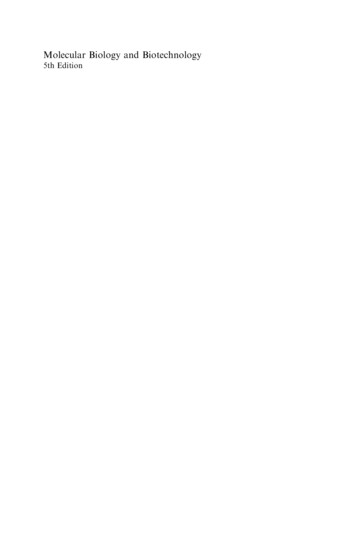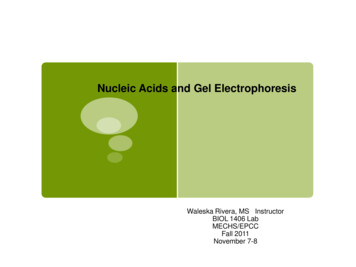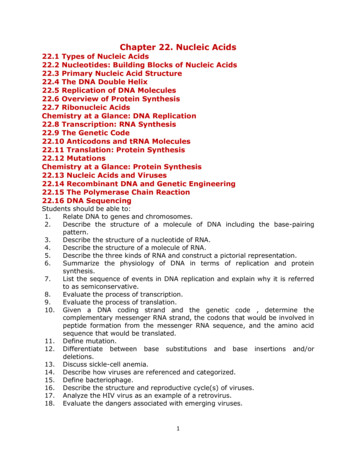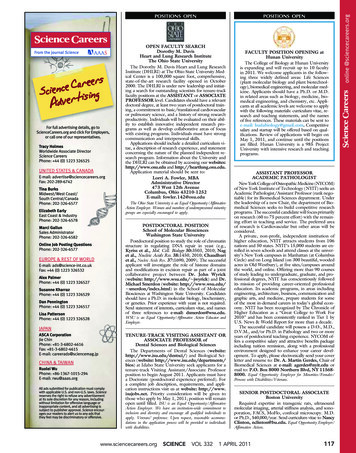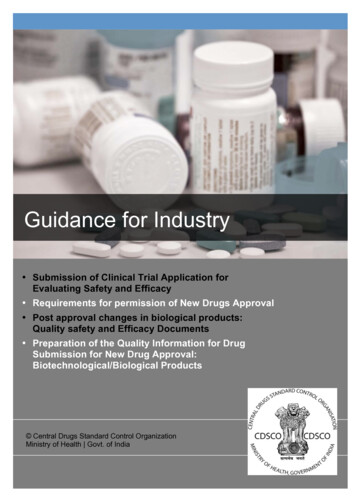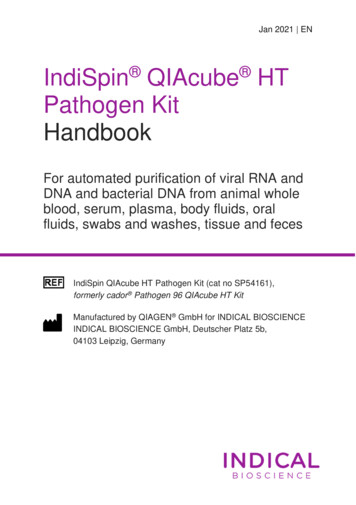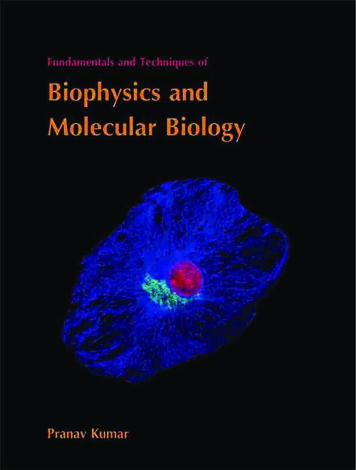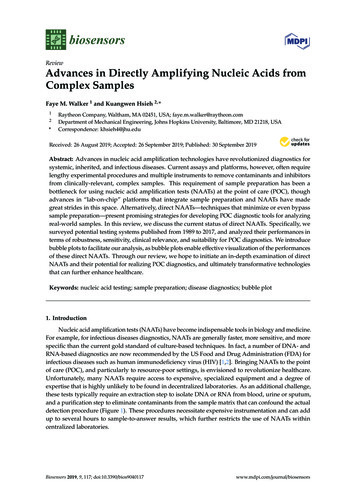
Transcription
biosensorsReviewAdvances in Directly Amplifying Nucleic Acids fromComplex SamplesFaye M. Walker 1 and Kuangwen Hsieh 2, *12*Raytheon Company, Waltham, MA 02451, USA; faye.m.walker@raytheon.comDepartment of Mechanical Engineering, Johns Hopkins University, Baltimore, MD 21218, USACorrespondence: khsieh4@jhu.eduReceived: 26 August 2019; Accepted: 26 September 2019; Published: 30 September 2019 Abstract: Advances in nucleic acid amplification technologies have revolutionized diagnostics forsystemic, inherited, and infectious diseases. Current assays and platforms, however, often requirelengthy experimental procedures and multiple instruments to remove contaminants and inhibitorsfrom clinically-relevant, complex samples. This requirement of sample preparation has been abottleneck for using nucleic acid amplification tests (NAATs) at the point of care (POC), thoughadvances in “lab-on-chip” platforms that integrate sample preparation and NAATs have madegreat strides in this space. Alternatively, direct NAATs—techniques that minimize or even bypasssample preparation—present promising strategies for developing POC diagnostic tools for analyzingreal-world samples. In this review, we discuss the current status of direct NAATs. Specifically, wesurveyed potential testing systems published from 1989 to 2017, and analyzed their performances interms of robustness, sensitivity, clinical relevance, and suitability for POC diagnostics. We introducebubble plots to facilitate our analysis, as bubble plots enable effective visualization of the performancesof these direct NAATs. Through our review, we hope to initiate an in-depth examination of directNAATs and their potential for realizing POC diagnostics, and ultimately transformative technologiesthat can further enhance healthcare.Keywords: nucleic acid testing; sample preparation; disease diagnostics; bubble plot1. IntroductionNucleic acid amplification tests (NAATs) have become indispensable tools in biology and medicine.For example, for infectious diseases diagnostics, NAATs are generally faster, more sensitive, and morespecific than the current gold standard of culture-based techniques. In fact, a number of DNA- andRNA-based diagnostics are now recommended by the US Food and Drug Administration (FDA) forinfectious diseases such as human immunodeficiency virus (HIV) [1,2]. Bringing NAATs to the pointof care (POC), and particularly to resource-poor settings, is envisioned to revolutionize healthcare.Unfortunately, many NAATs require access to expensive, specialized equipment and a degree ofexpertise that is highly unlikely to be found in decentralized laboratories. As an additional challenge,these tests typically require an extraction step to isolate DNA or RNA from blood, urine or sputum,and a purification step to eliminate contaminants from the sample matrix that can confound the actualdetection procedure (Figure 1). These procedures necessitate expensive instrumentation and can addup to several hours to sample-to-answer results, which further restricts the use of NAATs withincentralized laboratories.Biosensors 2019, 9, 117; sors
Biosensors 2019, 9, 117Biosensors 2019, 9, x FOR PEER REVIEW2 of 292 of 28Figure 1. Direct nucleic acid testing is much more convenient and streamlined than the three-stepFigure 1. Direct nucleic acid testing is much more convenient and streamlined than the three-stepmethod with preparatory techniques. In a typical extraction experiment, buffer with lytic agents ismethod with preparatory techniques. In a typical extraction experiment, buffer with lytic agents isadded to dilute the sample and homogenized with a mixer. Sonication creates pressure waves thatadded to dilute the sample and homogenized with a mixer. Sonication creates pressure waves that burstburst the cells in mechanical lysis. Lysozyme enzymatically destroys cells, and is removed from thethe cellsin mechanicallysis.andLysozymeenzymaticallydestroys cells,phaseand isseparation.removed fromthe reactionreactionwith vortexingcentrifugationin a phenol/chloroformThe DNAiswith precipitatedvortexing on.TheDNAisprecipitatedin fresh ethanol and the resulting mixture is washed to remove excess contaminants.in freshethanolthe resultingwashedto removecontaminants.Excessliquidandis removedso thatmixturethe DNAiscanbe resuspendedin excessan appropriatebuffer. Excess liquid isremoved so that the DNA can be resuspended in an appropriate buffer.Many groups have attempted to develop portable, integrated, microfluidics-based platforms toManyhave attemptedto developintegrated,platformstoincreasegroupsthe functionalityof diagnosticsensingportable,and analysis[3–5], andmicrofluidics-basedsome of these have ase the functionality of diagnostic sensing and analysis [3–5], and some of these have even beenDiagnostic’s MiniLab).These platformspresent easyQbreakthroughtechnologiesfor rapid, cost-effective,commercialized(e.g., bioMerieux’sNucliSENStests, TwistDx’sTwistAmpkits, and beseenwhetherthesesystemssimple and andDiagnostic’s MiniLab). These platforms present breakthrough technologies for rapid,arecost-effective,error-free enough for developed and developing settings, they demonstrate the feasibility ofuser-friendly diagnostics. While it remains to be seen whether these systems are simple and error-freeimplementing existing nucleic acid amplification methods for POC use [6–9].enough for developed and developing settings, they demonstrate the feasibility of implementingAn alternative approach to time-consuming and cumbersome sample preparation is performingexistingnucleicacid amplificationfor POC1).use[6–9].NAATsdirectlyfrom complex methodssamples (FigureTheadvantage of traditional amplificationAnalternativeapproachto time-consumingand cumbersomesample preparationperformingtechnologies,suchas PCR withreal-time spectroscopicor mass spectrometrydetection, ).Theadvantageoftraditionalamplificationresults are highly specific and quantitative. However, these sensing platforms are expensive andtechnologies,suchas PCRspectroscopicrequire priorextractionof withgeneticreal-timematerial fromthe sample. or mass spectrometry detection, is thatDirectNAATsare advantageouswhen complicated,costlylaboratoryapparatusesare not andthe resultsare highlyspecificand quantitative.However, thesesensingplatformsare expensiveavailable.They not onlyreduce materialthe time, fromlabor,theandsample.technical constraints of molecular testing, butrequireprior extractionof geneticalso bringthe additionalbenefit ofwhenstandardizingresultscostly[10]. Indeed,a growingnumbergroupsDirectNAATsare notavailable.are developing such “direct” NAATs. Most notably, the Alere i Influenza A&B assay became the firstThey not only reduce the time, labor, and technical constraints of molecular testing, but also bring theFDA Clinical Laboratory Improvement Amendments (CLIA)-waived nucleic acid-based test [11] inadditional benefit of standardizing results [10]. Indeed, a growing number of groups are developingJanuary 2015. As the Alere i system requires no front-end nucleic acid extraction, and can be usedsuch outside“direct”ofNAATs.Mostnotably,sitesthe [12–16],Alere i itsInfluenzaA&B assaybecame thestatusfirst FDAClinicaltraditionallaboratorydevelopmentand ng support for further development of direct assays that can minimize or even bypass sample 2015.As theAlere i system requires no front-end nucleic acid extraction, and can be used outside of present the currentof direct assaysandplatformsthat supportachieve nucleiclaboratorysites[12–16], itsand stateCLIA-waivedstatusprovidestrongfor furtheracids detectionandassaysanalysisfromcomplexwith either minimal ordevelopmentof directthatcanclinically-relevant,minimize or evenbypasssamplessamplebutpreparation.Thus motivated, we present the current state of direct assays and platforms that achieve nucleicacids detection and analysis from clinically-relevant, complex samples but with either minimal or
Biosensors 2019, 9, 1173 of 29even no sample preparation procedures. We surveyed the literature from 1989–2017 and came acrossa significant number of works that reported NAATs from bodily samples (e.g., blood-based liquids,oral samples, swabs) without the complex steps generally involved in sample preparation. This meantdiscarding the works that depended on sophisticated instruments and operations that are labor-,time-, and cost-intensive, such as enzymatic (proteinases), chemical (acids, detergents), or physical(temperature shock, mechanical disruptions) treatments. Then, we describe examples whereby datavisualization can be used to reveal the connections between the robustness, sensitivity, and efficacyof technologies developed for direct DNA- and RNA-based tests. It is our hope that in reviewingtechnologies such as these, and presenting these promising early findings in an information-rich andaccessible fashion, we can help to accelerate the development of approaches that make POC nucleicacid testing rapid, accurate, simple, and affordable.2. MethodsIn order to find relevant articles with data on NAAT parameters, we performed literature searchesfrom December 2014 to February 2018.2.1. Literature SearchWe searched Google Scholar with a combination of search terms. These followed a formulaof combining a descriptor (e.g., “point-of-care”), an amplification technology (e.g., “LAMP” OR“loop-mediated isothermal amplification”) and a sample matrix (e.g., “blood”). References ofpreviously published reviews, as well as those included in original studies, were checked for possiblecandidate articles.2.2. Record ScreeningArticles were initially screened on the title, and secondly on the abstract. Any articles that relied onmicrofluidic platforms or commercialized extraction devices were excluded. Publications that requiredcomplex pre-processing with enzymatic treatment or chemical purification were not selected. Studieswere included if they involved direct amplification and detection of genetic material from one of sixrepresentative sample types: blood, dried blood spot, serum and plasma, saliva and sputum, swabs,urine, and stool. The full text of appropriate articles was read to extract the necessary information.2.3. Data AbstractionFrom each of the 174 published works surveyed, we extracted and recorded data that correspondedto test performance. There are many parameters that cannot be ignored when considering NAATs:accuracy, specificity, user-friendliness, training requirements, and so on. As such, we provide anextensive examination of nucleic acid template specificity (including single or multiplexed reactions),amplification methodologies (enzymes, operating temperatures, and amplification technology),and user-friendliness (storage considerations, pretreatment requirements, and physical involvement)in Supplementary Table S1.In addition, we have classified assays that can feasibly be completed without extensive trainingor high-end instrumentation as “direct,” whereas those with greater labor or equipment demands(e.g., freezers, high-speed centrifugation, or incubation for multiple hours) are deemed “semi-direct.”Specifically, the “semi-direct” assays have the following exceptions to a simple laboratory setup:alternating between two or more incubation temperatures (other than room temperature), relyingon enzymatic activity, or requiring more than a brief, low-speed ( 100 g) centrifugation. Methodscategorized as “semi-direct” face some hurdles to implementation as an on-site service for patient care.What these tests do offer is a way to deliver actionable results that can link diagnosis to treatment.With appropriate conversion from requirements for highly trained staff and sophisticated tools toeasy-to-use methods, “semi-direct” procedures will meet the requirements for POC diagnostic devices.
Biosensors 2019, 9, 1174 of 292.4. Visualization ProcessWe found certain parameters could be distilled into numerical data, yielding particularly usefulinsights when examining different tests. We have devised three major criteria that are indicative ofeach platform’s robustness, sensitivity, and clinical efficacy:1.2.3.Tolerance to the sample of interest—ideally, the assay should be able to detect its target againsta high concentration of background contaminants. We note that, although sample dilutionsometimes provides a convenient way of permitting amplification, doing so inevitably reducesthe limit of detection (LOD). Most NAATs analyze only a fraction of the sample volume. Sampledilution therefore increases the likelihood of false negative results, especially when the samplesalready have low target concentrations.LOD—by foregoing sample preparation, one generally sacrifices the opportunity to concentratebulk samples, reducing the limit of detection and making sensitivity an important consideration.Clinical evaluation—recognizing assays that have been validated with clinical samples.Finally, we sought to devise a visual strategy that would clearly and quickly communicate theimportance of our criteria, compare the wide range of assays, discover trends in the data, and revealpatterns in a single glance. Specifically, the essential information of the 174 reviewed publications ispresented quantitatively in a single plot. Relevant values are standardized and communicated in termsof visual attributes of position, size, shape, and color.We have found it particularly useful to visualize the data as “bubble plots.” In a bubble plot,numerical values from three parameters are simultaneously visualized via the two axes and the size ofthe circular marker. Different categories can also be grouped according to the color of the markers.In our case, we can readily display the essential information (e.g., sample tolerance, LOD, and instancesof clinical testing) of related procedures to discern those that enhance test performance.3. Brief Overview of Isothermal Amplification TechniquesIn our survey, we came across eight DNA- and RNA-based testing techniques. As expected, PCR(and reverse transcription PCR, or RT-PCR) has been the predominant technique. Notably, a number ofisothermal amplification techniques have also been used to develop direct NAATs. Herein, we providebrief overviews of these lesser known isothermal amplification techniques.3.1. LAMPWhile PCR is the most commonly reported method of amplification, there is an increasingnumber of isothermal amplification technologies that can be truly used at the POC. The singlereaction temperature enables the use of less costly, complicated instruments than for thermal cyclingtests. Loop-mediated isothermal amplification (LAMP) is one such widely researched, developed,and characterized method [17]. Amplification employs a strand-displacing polymerase and two orthree pairs of primers: one that is sacrificed to linearize the template, and one or two others that primethe DNA synthesis to produce concatenated, cauliflower-like products [18]. As with PCR, LAMP hasbeen modified to target RNA as reverse-transcription (RT)-LAMP [19].LAMP has been compared to PCR in other ways as well, including applications with bacterial,viral, fungal, and parasitic assays. Not only has the specificity and sensitivity been equivalent to thatof PCR, the robustness of LAMP to certain preparations of serum, swabs, and blood has shown it to bemore tolerant to inhibitors than PCR [8].3.2. NASBAThe nucleic acid sequence-based amplification (NASBA) method is unique in its ability toamplify single-stranded RNA directly [20]. This is most desirable for targeting RNA viruses andfor transcriptome analysis [8]. The continuous, homogeneous, isothermal process relies on RNA
Biosensors 2019, 9, 1175 of 29polymerase, RNase, and reverse transcriptase. First, the reverse transcriptase creates a double strandedRNA:DNA hybrid from the RNA template; next, the original RNA is destroyed; a DNA duplex issynthesized; then, the polymerase can transcribe RNA from the DNA. Each new RNA molecule canrepeat the cycle for exponential amplification.NASBA has been applied to a wide-ranging set of research problems, including HIV diagnosis duringthe AIDS epidemic of the 1990s and automated, real-time, clinical tests in blood with the modern NucliSENS(bioMerieux, Inc., Durham, NC, USA) or in urine with the APTIMA assay (Hologic, San Diego, CA, USA).NASBA is also used outside of the commercial sector with systems to monitor viruses in serum [21].3.3. SDAThe strand displacement amplification (SDA) technique is based upon the abilities of a restrictionenzyme and a DNA polymerase. A primer containing a recognition sequence for the restrictionenzyme binds to its complementary, single stranded DNA target. After extension by the polymerase,the restriction enzyme nicks the unmodified strand of the double-stranded hemiphosphorothioaterecognition site. DNA polymerase then extends the 30 end of the nick, displacing the downstreamstrand. The end result is exponential target amplification from the displaced strands, which serve astargets for new reactions.SDA is not complex, but it does suffer from sensitivity issues in the presence of background DNA.The best way to overcome off-target amplification, and hence reduce false-positives, is to use simplepretreatment procedures like those that have been developed for detection with the BDProbe-Tec(Becton Dickinson Microbiology Systems, Sparks, MD, USA) and in-house systems for urine [22].3.4. RPARecombinase polymerase amplification (RPA) avoids thermal cycling by using three core proteinsthat operate optimally between 37–40 C [23]. The first protein, recombinase, binds to primers thatrecombine with a duplex target for strand displacement. The second, a single-stranded DNA bindingprotein, attaches to the displaced strand before a strand-displacing polymerase copies the DNA fromthe primer onwards for exponential amplification.One of the requirements for RPA technology is sequence-specific detection. This avoids the problemof primer artifacts that add to background fluorescence with nonspecific, intercalating dyes. With itsspecific readout and rapidity ( 20 min to results) as two main features, RPA provides an alternative to thetime-consuming processes of culturing and bacterial genotyping when testing for pathogens [7].3.5. SIBAStrand invasion based amplification (SIBA) is another amplification process that relies onrecombinase activity. In SIBA, there is a separate recombinase substrate that is inserted between twoprimer-binding sites. The duplex peripheral to this insertion site is separated, enabling the primers tobind. DNA polymerase can then extend the template from the bound primers. This use of an invadingsubstrate, one that is neither consumed nor included in the extension of DNA, is advantageous becauseit abolishes primer artifacts. SIBA can therefore be used to reliably detect low copy numbers ofpathogens—other isothermal methods generate non-specific amplification products in the absenceof target DNA [24]. Going further, the specificity of SIBA enables multiplexing for the detection oftemplates that differ by as little as two bases [25].3.6. MDAMultiple displacement amplification (MDA) is a technique that exploits the strand displacement,proofreading, and polymerase activity of the φ29 bacteriophage DNA polymerase [26]. The highlyprocessive polymerase uses random primers to amplify an entire genome. MDA is therefore well-suitedfor whole genome amplification from crude biological samples, which can be followed by singlenucleotide polymorphism (SNP) testing and genotyping [8].
Biosensors 2019, 9, 1176 of 293.7. HCRThe concept of hybridization chain reaction (HCR) [27]—an enzyme-free, room-temperatureBiosensors 2019, 9, x FOR PEER REVIEW6 of 28method—relies on a DNA trigger to initiate amplification. The initiator interacts with two stableDNA hairpins3.7. HCR to create nicked double helices. Amplification of this initiation event continuesuntil the hairpins are depleted. HCR is a useful assay for detecting short DNAs, such as humanThe concept of hybridization chain reaction (HCR) [27]—an enzyme-free, room-temperatureimmunodeficiencyvirustypetrigger1 (HIV-1)in serum[28]. The initiator interacts with two stable DNAmethod—relieson a DNAto initiateamplification.hairpins to create nicked double helices. Amplification of this initiation event continues until the4. Analysisof SurveyedDirectNAATshairpinsare depleted.HCRis a useful assay for detecting short DNAs, such as humanimmunodeficiency virus type 1 (HIV-1) in serum [28].4.1. Growing Prevalence of Direct NAATs4. Analysis of Surveyed Direct NAATsTime-series plots offer an effective means for showing the growing prevalence of direct NAATs.Specifically,withineach sample4.1. GrowingPrevalenceof Direct type,NAATswe plotted the number of clinical samples that have beenanalyzed bydirect NAATs from 1989 to 2017 (Figure 2). Here, we also divided the data into twoTime-series plots offer an effective means for showing the growing prevalence of direct NAATs.cohortsSpecifically,based on whethersamplesPCR(Figureblack)or isothermalwithin eachsampleweretype,subjectedwe plottedtothenumberof 2,clinicalsamplesthat ected,wesawanoverallriseinthenumberof clinicalanalyzed by direct NAATs from 1989 to 2017 (Figure 2). Here, we also divided the datainto twosamplescohortsbased onwhethersamplessubjectedto PCR(Figure2, black) period.or isothermalanalyzedvia NAATswithminimalor no weresamplepreparationoverthe analyzedAcross all ,wesawanoverallriseinthenumberof clinicalsamples.sample types, we observed sharp spikes, which indicate studies of high numbers of clinicalsamples analyzed via NAATs with minimal or no sample preparation over the analyzed period.Based on the sample type, swab samples had been most analyzed, while urine and stool samples hadAcross all six sample types, we observed sharp spikes, which indicate studies of high numbers ofbeen leastanalyzed.sampletype,type,afteran initiallag,mostwe sawa notablethe use ofclinicalsamples.WithinBased oneachthe sampleswabsampleshad beenanalyzed,while ol samples had been least analyzed. Within each sample type, after an initial lag, we saw a notableafter thein the useof isothermalamplificationtechniques.This first becameapparentas earlyas 2003,systemsadvent riseof LAMPin 2000,and twelveyears afterthe introductionof NASBA[20].PCR-basedseveralyearsafterthe adventLAMP in 2000,and twelveintroductionof NASBAemergedwithinfiveyearsof theoftechnique’sinceptionin years1986after[29],theandPCR largelycontinues to[20].thePCR-basedsystemsemergedwithin fiveyearsof thetechnique’sinceptionin 1986PCRdominaterealm ofnucleicacid testing.Theonenotableexceptionis seenin[29],ourandtime-courseoflargely continues to dominate the realm of nucleic acid testing. The one notable exception is seen inblood testing, where isothermal techniques have surpassed PCR and RT-PCR in terms of the numberour time-course of blood testing, where isothermal techniques have surpassed PCR and RT-PCR inof assaysperformedon wholebloodsamples.termsof the numberof assaysperformedon whole blood samples.2. Time-seriesdirectnucleicacidacid diagnosticsaccordingto accruednumberof samplesFigure Figure2. Time-seriesdatadatafor fordirectnucleicdiagnosticsaccordingto accruednumberof samplestested. Individual plots of number of clinical samples over time are subdivided according to sampletested. Individual plots of number of clinical samples over time are subdivided according to samplematrix as follows: (a) whole blood, (b) dried blood, (c) plasma and serum, (d) saliva and sputum,(e) oral, dermal, and conjunctival swabs, and (f) urine and stool.
Biosensors 2019, 9, 117Biosensors 2019, 9, x FOR PEER REVIEW7 of 297 of 284.2. DirectmatrixNAATsfor WholeBloodblood, (b) dried blood, (c) plasma and serum, (d) saliva and sputum, (e)as follows:(a) wholeoral, blooddermal,containsand conjunctivalswabs,nucleicand (f) urinestool.Becausecirculatingacids,andcells,and over 20,000 different proteins, it offers anabundance of biomarkers for disease detection. Molecular diagnostics in blood are useful for detecting4.2. Direct NAATs for Whole Bloodspecific DNA or RNA sequences from a range of bacterial, toxic, and viral infectious agents. PlatformsBecausecontainscirculating nucleicvirusacids,[30],cells,Staphylococcusand over 20,000 differentproteins,offersfor hepatitisandbloodhumanimmunodeficiencyaureus [31],and itPlasmodiuman abundance of biomarkers for disease detection. Molecular diagnostics in blood are useful forspecies are just a few of the most-used systems enabling rapid diagnostics in whole blood.detecting specific DNA or RNA sequences from a range of bacterial, toxic, and viral infectious agents.Blood-based testing generally demands sophisticated detection instruments or extensivePlatforms for hepatitis and human immunodeficiency virus [30], Staphylococcus aureus [31], andpreparationto t allinhibitorybloodcomponentsPlasmodiumspecies arejust a few of thesystemsenablingrapiddiagnosticsin wholeblood. areknown ulinG(IgG)canallinterfereBlood-based testing generally demands sophisticated detection instruments or extensivewith preparationamplificationreactionsby inhibitingDNA polymeraseactivity[33]or chelatingnecessaryto recoverinhibitor-freeand high-purityDNA. Not allinhibitorybloodcomponentsareknown[32], butheme compounds,anticoagulants,andimmunoglobulinG (IgG)can allcofactors[34,35].Althougha wide rangeof bloodborneviruses,bacteria, andparasitescaninterferein principlewith amplificationreactionsby inhibitingDNA polymeraseactivity [33] meansor chelatingnecessarythesebe detectedwith nucleicacid testing,extractionand purification-freeof dborneviruses,bacteria,andparasitescan inpathogens are not currently commercially g,extractionandpurification-freemeansofdetectingWe have visualized the general trends of direct and semi-direct nucleic acid testing in blood as athese pathogens are not currently commercially available.function of the LODs (Figure 3). The % (v/v) of blood tolerated in a reaction is plotted against the LODWe have visualized the general trends of direct and semi-direct nucleic acid testing in blood asin g of template, with the number of clinical samples encoded as the area of the bubble. We have alsoa function of the LODs (Figure 3). The % (v/v) of blood tolerated in a reaction is plotted against theassignedto indicatethethetypeof amplificationtechnology.evidentmany WestudiesLOD colorsin g of template,withnumberof clinical samplesencoded Itasisthearea of thatthe bubble.have haveachievedhigh sensitivityin detectingtheirtarget in a lowconcentrationof blood.Thisstudiesshows thatalso assignedcolors to indicatethe typeof amplificationtechnology.It is evidentthat sedtestsinPOCsituationswherecollectionvolumeshave achieved high sensitivity in detecting their target in a low concentration of blood. This showsthat nucleicacid testinghasandgreatpotentialfor blood-basedin POCsituationswhereare small(e.g., fingerpricks)parasiteloadsmay be low.testsThoseexamplesfromthe collectionliterature thatare small (e.g.,finger samplespricks) andloadsmay be low.Thosefrom theby Xswere volumesnot demonstratedon patientare parasiteconsideredseparatelyin theplot,examplesand representedliteraturethat werenot demonstratedon patientsamples arein thatthe plot,andbelowratherthan bubblemarkers.Some of theseare purportedtoconsideredhave veryseparatelylow meofthesearepurportedtohaveverylowLODsthe fg level (Table S1)—it remains to be seen whether such tests will perform with the same extremethat reach below the fg level (Table S1)—it remains to be seen whether such tests will perform withsensitivity in a clinical context.the same extreme sensitivity in a clinical context.Figure 3. Bubble plot of nucleic acid diagnostics performed in whole blood. Percent concentration (v/v)of bloodper3.reactionin aofgivenprocedureis displayedas a infunctionof thePercentlimit ofconcentrationdetection (LOD)FigureBubble plotnucleicacid diagnosticsperformedwhole blood.in g oftemplate.numberinofapatientsamples istestedis proportionaltooftheof themarker area,(v/v)of blood Theper reactiongiven proceduredisplayedas a functiontheloglimitof detectionas shown at top, and the testing methodology is indicated by marker color. Cases shown with insteadof bubble markers illustrate that patient testing was not reported.
Biosensors 2019, 9, 1178 of 29By assessing the PCR- and isothermal-based data, we could obtain some insight into how tooptimize these techniques to better tolerate blood as a sample matrix. Several of the semi-direct workswith PCR have employed over 50% blood in a reaction after heat-cold shock [36]. More noteworthyis a truly direct example that relied on the specificity and efficacy of the Phusion polymerase (NewEngland Biolab, Ipswich, MA, USA) to perform PCR in 40% blood [37]. PCR typically employsthe Taq polymerase from Thermus aquaticus. Chemical additives, whether commercially-availablecocktails [38,39] or in-house buffers [39–52], allow the Taq family of polymer
As the Alere i system requires no front-end nucleic acid extraction, and can be used outside of traditional laboratory sites [12-16], its development and CLIA-waived status provide strong support for further development of direct assays that can minimize or even bypass sample preparation.
